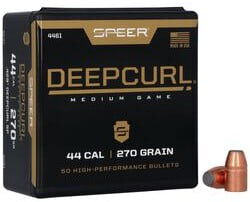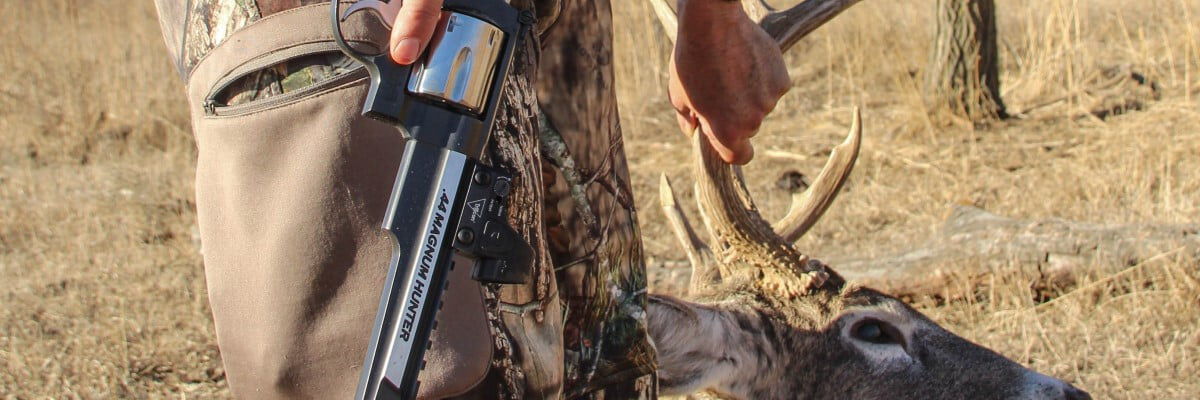
On the surface, it doesn’t make much sense to hunt with a firearm that often requires you to get within bow range of an animal to make a shot. That fact long prevented me from taking up handgun hunting. But on a South Texas whitetail hunt, I shot my first big game animal with a handgun, and since then I’ve turned back to it at every opportunity.
My primary motivator is simple: Hunting with a handgun requires me to be patient and get close to the animal to make a clean, killing shot. It places demands on the hunter that a rifle simply does not. In many instances, the success hinges less on marksmanship (although you’ll need it) and more on the ability to close the distance and get up close and personal with an animal. The risk of being spotted or simply being unable to get within range is high, but the rewards of stalking close to a free-ranging animal and making an effective shot with a handgun outweigh the regret of not filling a tag on every hunt.
Gear & Guns
Choosing the right handgun is a critical first step, and you must match caliber and action type to the animal. Traditionally, handgun hunters have chosen a revolver or single-shot, and both are good. But today’s crop of semi-auto pistols in 10mm Auto offer a list of suitable options as well, and they are light and easy to carry. A 1911-style 10mm with a 5- or 6-inch barrel, reflex sight, and high-quality hunting ammunition is great for deer where legal. Those also make great hog guns, especially when you’re hunting over bait or dogs where shots might be close and quick.

DeepCurl
We electrochemically bond the DeepCurl jacket to its lead core to create the toughest, most accurate handgun hunting bullet possible.
Buy NowAnother effective handgun platform is a bolt-action, though they are less commonly seen in the field. They allow for the use of modern centerfire cartridge and make mounting a magnified optic very easy. Plus, with a steady rest, these guns can be incredibly accurate, extending effective range to near-rifle distances. Of course, they require a great deal of practice, and these guns are so large that it’s best to carry a tripod or some other device to stabilize them in the field.
One of the great advantages of hunting with a handgun is that, in a proper holster, they allow you to have your hands free. This is great when walking in steep country or while climbing into or out of a treestand (provided the holster does not impede movement). Hog, bear and mountain lion hunters who use hounds also like handguns because the shots are generally close and a holstered pistol or revolver leaves the hands free to catch dogs.
Optics aren’t mandatory, but they help. Traditionally, handgun hunters have turned to scopes, and they’re a fine option. I have a 4x scope on my Ruger Super Redhawk, and that’s my go-to deer handgun because it makes shot placement easier. Today, however, I would argue that red dot optics are almost as versatile as magnified scopes. In some instances, like while hunting in dense cover, a red dot sight is actually easier to use, and with so many handguns offering milled receivers or top rails, mounting a red dot is a simple, effective option. I used a Trijicon SRO on a Smith & Wesson 44 Magnum in Nebraska and had no issues shooting a good buck at 50 yards.

I never handgun hunt without some means to stabilize the firearm. Oftentimes that’s a collapsible shooting stick or bipod, but if you’re hunting from a blind or planning to take relatively long shots, a tripod with a vice is a good option as well.
Cartridges & Loads
You can spend a lot of time debating which handgun calibers are best for hunting, but there are some solid options that work well for a wide variety of game. For deer-sized game, loads from 357 Magnum to 500 S&W work, but it’s hard to beat the versatility of the classic 44 Magnum. I’ve taken several deer with it and have never felt that it lacked power to put whitetails down out to 100 yards, provided the shot was well-placed. Larger rounds like the 454 Casull shoot flatter and pack more punch, but they aren’t as easy to shoot.
I’m more particular about the bullet I use. I once killed a deer with an inexpensive 44 Magnum JSP, but it wasn’t a clean kill, and I won’t do that again. I’ve since learned to look for a well-constructed bonded bullet designed for the task. One of my favorites is Speer’s DeepCurl. It offers everything I need for big game hunting. The electrochemically bonded jacket will not separate from the core, and that equates to deep, straight-line penetration. Pre-formed petals initiate expansion and result in consistent upsets and massive energy transfer. Those are critical factors when choosing the right hunting bullet. Place a Deep Curl in the vitals and you can expect reliable, fast results.
Handgun hunting certainly isn’t for everyone, but those who take up the mantle will be rewarded with a lifetime of enjoyment. It requires great skill as a hunter to get close to game and make an effective shot with a handgun, but it is possible. Practice is key, so plan on spending time at the range, and choose your equipment wisely.